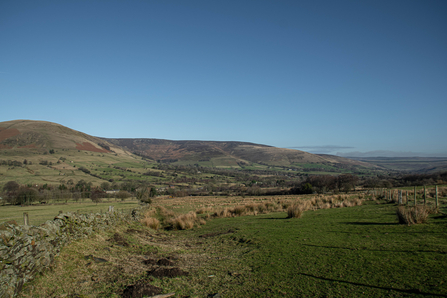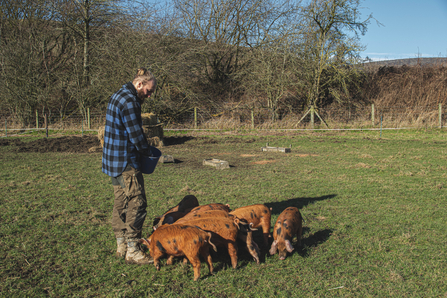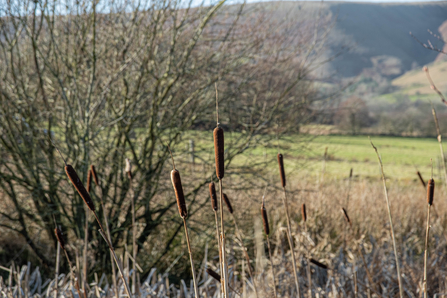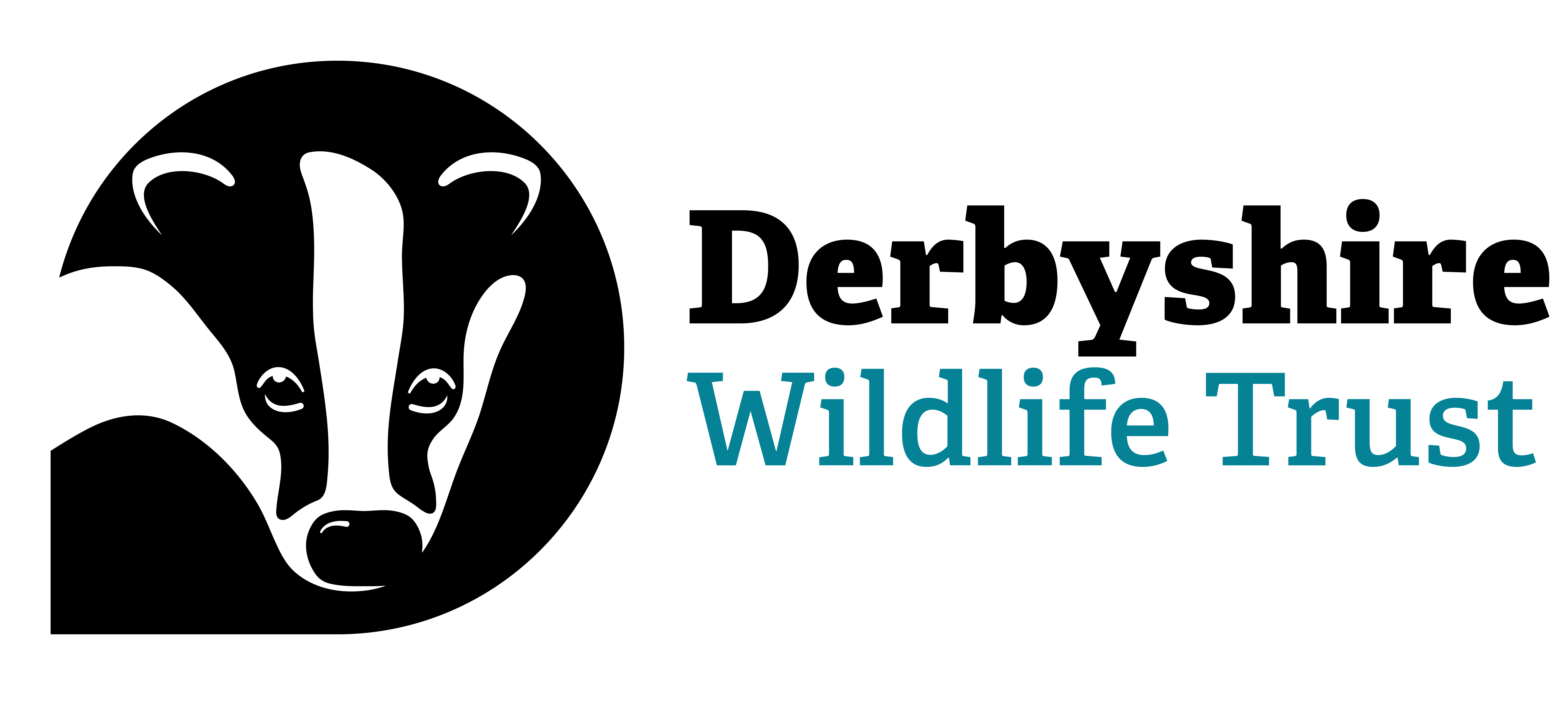George is one of many farmers who are taking the step towards rewilding. George is the owner of 'Become Wild', set amongst the hills in Edale, Peak District. Aside from George's business, he owns a patch of land, where he aims to turn that land into a haven for wildlife.
Wild Peak Programme: Become Wild
The work we are carrying out with the landowner is not associated with their planning application or the land covered by the planning application, we are surveying the land outside of this boundary and using the data to create a management plan that will be of benefit for wildlife and the wider ecosystem.

George's land (c) DWT
Introduction
Hello, my name's George, and I live out here in Edale. I've been here for four years, having served 10 years in London and toiling away in the city.
Where did you hear about the Wild Peak Programme and what made you want to get involved?
That's an excellent question actually. We had someone from Derbyshire Wildlife Trust come out for a site visit before the Wild Peak Programme was a thing. A very nice lady came out to give us some advice on the potential here for restoring habitats. She mentioned that the whole programme was starting to come together and that would really suit landowners of our size. And so we said we would want to be involved. I think we proactively reached out to the Trust to see if they want if they'd come out and give us some advice in the first place, and we are very pleased that we did.
Tell us about your idea about funding rewilding through an eco friendly business?
We've spent time looking at the rural economy in terms of what works well and what doesn't work well. The Peak Park is a beautiful, beautiful tourist facility, the major cities around here, Manchester, Sheffield, Leeds, have a place of recreation to come. With the the weight of people that can come and visit the National Park, the income they can bring when they come can fund anything that wants to be done here. They can fund farming, conservation, farm and village development and schools. I just don't think we're doing the best job at capturing that potential spend currently. So my idea was that with all these people coming and staying, how do we encourage them to buy local food? First and foremost, we need to make local food available. How do we encourage them to spend a bit of money with the farm they stay at or leave a bit of money to a conservation project or towards planting trees? We've got to make that process available for them to do, you've got to show it to them. You've got to talk to them about it. So the thinking that I had was with the sheer volume of people that could come and visit the Peak Park over the course of the year, how do you turn that into paying for conservation as opposed to turning around, asking the government for handouts for conservation? There are places all over the country whereby they're not blessed with the scale and beauty of the National Park has. Therefore that funding is better directed into those areas and to support those farmers and agricultural outfits that need that funding more, in my opinion. But I think there's a really good opportunity for enterprise of a small, considered nature to get tourism to pay for conservation here in the Peak District.

George and his pigs (c) DWT
Talk us through your thoughts on rewilding as a farmer. What is it about rewilding that you were drawn to?
What got us interested in it was the challenge of finding the balance between agriculture, conservation and viable income streams. I think back to my grandparents, who were farmers. They worked the land before there was any proper machinery to do it. They always had a view that if they're not protecting what they're farming, then ultimately they don't have anything to pass on down the generations. I've not had anything passed on to me, we've purchased the land ourselves. But if we don't look after it, there's nothing for us to pass on, especially given the nature of the declining biodiversity around here, especially given the climate and the changes that are going on there. This place should be an epicentre for encouraging change. But that's very difficult. I think it comes back to the economics of it all mainly, so the concept for me is finding a balance. How can I farm? How can I have an income and conserve as much of what I own as possible and enhance it? I think we probably farm 25-30% of our holding. Our tourism is then based on a further 10% and we're setting aside for conservation, 60% of the land that we own. We think if we get that right, the smallest part, the tourism pays for all the rest of it. To to do what I consider to be rewilding properly and conservation properly, you first have to witness what's going on. And then you have to monitor the changes over time and make any adaptations encouraging certain things and discouraging certain things there are hidden costs in all of those aspects that need to be prepared for costed for.
What are your goals in the next year or so?
So we're already running a glamping site, at the moment it's on leased land just around the corner from here. So a key goal for us, is to get planning permission to move that on to our own land, that is a real economic game changer for us as we then get to keep that lease money we are currently spending in our bottom line. Planning has its challenges but we are already started with a phase of doing what I think comes first in rewilding, which is just watching what happens. There's sections of our land which we've completely taken grazing pressure away from, and we just stand back and witness what happens over a whole season. The challenge now is to take grazing pressure off as much of our land as possible and spend time witnessing what's going on. Take those baseline surveys, which will be done with the good folks at the Derbyshire Wildlife Trust, via the Wild Peak Network. Then start to plan our actions. The best example of that is the area where there are already 3 ponds here, they were established about a decade ago with a little bit of planting and then they were kind of segregated out from from the rest of the holding. Something we have started to get our teeth into it straight away is putting in another bigger pond to expand that network and hopefully encourage more diversity. And that hopefully then is a stepping stone to improve what's going to be the rest of the site once we've relieved the main grazing pressure on it.

Pond on George's land (c) DWT
What advice would you give to others who want to get into rewilding?
The only real thing you need to do is to stop and look and listen. I think the bulk of the work we do here over the the next decade, we'll be doing nothing and it's kind of coming to terms with that. There will be strategic interventions along the way, and they need the right, professional input, but we're not going to be doing thing's that are rocket science. The biggest challenge, I think, is to shut out all of the exterior noise. Look at what you've got in front of you. Make informed decisions based on how that land operates. You know what's thriving, what isn't thriving. Ask yourself what would have been there if it hadn't been an agricultural site for 100 years? What would have been there 1000 years ago, 10,000 years ago, trying to be informed by the landscape around. I think you've got to make the best decision for you and your individual bit of land. Which isn't the easiest thing to do, but it's the necessary step. Come to your own decisions and then crack on and get it done.
To find out more about the Wild Peak programme follow the links below.
Please note that all works and questions relating to the adjacent planning proposal are for Peak Park.
